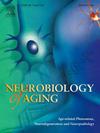Brain network connectivity underlying neuropsychiatric symptoms in prodromal Lewy body dementia
IF 3.7
3区 医学
Q2 GERIATRICS & GERONTOLOGY
引用次数: 0
Abstract
Neuropsychiatric symptoms (NPS) are prevalent, emerge early, and are associated with poorer outcomes in Lewy body dementia (LBD). Research suggests NPS may reflect LBD-related dysfunction in distributed neuronal networks. This study investigated NPS neural correlates in prodromal LBD using resting-state functional MRI. Fifty-seven participants were included with mild cognitive impairment (MCI) with Lewy bodies (MCI-LB, n = 28) or Parkinson’s disease (PD-MCI, n = 29). Functional MRI assessed connectivity within five resting-state networks: primary visual, dorsal attention, salience, limbic, and default mode networks. NPS were measured using the Neuropsychiatric Inventory. Principal component analyses identified three neuropsychiatric factors: affective disorder (apathy, depression), psychosis (delusions, hallucinations) and anxiety. Seed-to-voxel connectivity maps were analysed to determine associations between NPS and network connectivity. In PD-MCI, affective symptoms and anxiety were associated with greater connectivity between limbic orbitofrontal cortex and default mode areas, including medial prefrontal cortex, subgenual cingulate and precuneus, and weaker connectivity between limbic orbitofrontal cortex and the brainstem and between the salience network and medial prefrontal cortex (all pFWE<0.001). Psychosis severity in PD-MCI correlated with connectivity across multiple networks (all pFWE<0.001). In MCI-LB, no significant correlations were found between NPS severity and network connectivity. However, participants with anxiety demonstrated a trend towards greater connectivity within medial prefrontal areas than those without (pFWE=0.046). Altered connectivity within and between networks associated with mood disorders may explain affective and anxiety symptoms in PD-MCI. Neural correlates of NPS in MCI-LB, however, remain unclear, highlighting the need for research in larger, more diverse LBD populations to identify symptomatic treatment targets.
前驱路易体痴呆的脑网络连接基础神经精神症状
神经精神症状(NPS)在路易体痴呆(LBD)中普遍存在,出现较早,并且与预后较差相关。研究表明,NPS可能反映了分布式神经网络中与lbd相关的功能障碍。本研究利用静息状态功能MRI研究了前驱LBD的NPS神经相关。57名受试者被纳入轻度认知障碍(MCI)伴路易体(MCI- lb, n = 28)或帕金森病(PD-MCI, n = 29)。功能性MRI评估了五个静息状态网络的连通性:初级视觉网络、背侧注意网络、显著性网络、边缘网络和默认模式网络。使用神经精神量表测量NPS。主成分分析确定了三种神经精神因素:情感障碍(冷漠、抑郁)、精神病(妄想、幻觉)和焦虑。分析种子到体素的连接图,以确定NPS和网络连接之间的关联。在PD-MCI中,情感症状和焦虑与边缘眼窝前额皮质与默认模式区域(包括内侧前额皮质、亚属扣带和楔前叶)之间的连通性更强有关,与边缘眼窝前额皮质与脑干以及突出网络与内侧前额皮质之间的连通性较弱有关(所有pFWE<;0.001)。PD-MCI患者的精神病严重程度与跨多个网络的连通性相关(所有pFWE<;0.001)。在MCI-LB中,NPS严重程度与网络连通性之间没有显著相关性。然而,焦虑的参与者比没有焦虑的参与者表现出内侧前额叶区域更大的连通性(pFWE=0.046)。与情绪障碍相关的网络内部和网络之间连接的改变可以解释PD-MCI的情感和焦虑症状。然而,NPS在MCI-LB中的神经相关性仍不清楚,这表明需要在更大、更多样化的LBD人群中进行研究,以确定对症治疗靶点。
本文章由计算机程序翻译,如有差异,请以英文原文为准。
求助全文
约1分钟内获得全文
求助全文
来源期刊

Neurobiology of Aging
医学-老年医学
CiteScore
8.40
自引率
2.40%
发文量
225
审稿时长
67 days
期刊介绍:
Neurobiology of Aging publishes the results of studies in behavior, biochemistry, cell biology, endocrinology, molecular biology, morphology, neurology, neuropathology, pharmacology, physiology and protein chemistry in which the primary emphasis involves mechanisms of nervous system changes with age or diseases associated with age. Reviews and primary research articles are included, occasionally accompanied by open peer commentary. Letters to the Editor and brief communications are also acceptable. Brief reports of highly time-sensitive material are usually treated as rapid communications in which case editorial review is completed within six weeks and publication scheduled for the next available issue.
 求助内容:
求助内容: 应助结果提醒方式:
应助结果提醒方式:


